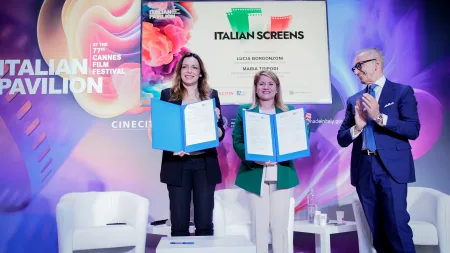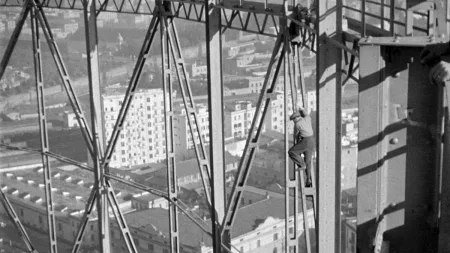17 April 2024
100 Years of Luce
The birth of Istituto Luce dates back to 1924, when Italy, like other countries, started exploring a powerful communication medium – film.

The first documentaries produced by the Institute were exclusively educational, aimed at disseminating knowledge in a country where literacy was still a challenge. The cinema screen, often set up in public squares, held a magnetic allure that printed paper could not match.
At its foundation, Luce was born as L.U.C.E. (acronym of “L’Unione Cinematografica Educativa”); the following year, a Royal Decree changed its name into “Istituto Nazionale Luce.” Luciano De Feo, a lawyer and journalist expert in international economic policy, had the first intuition that led to the creation of the oldest public institution in the world for the diffusion of cinema as an educational and information tool, soon followed by the drive of Benito Mussolini, who made the Institute a means to promote the image and raise consensus for the fascist regime.
Since then, Luce has documented and knotted with all the country’s historical and social stages, becoming a unique shelter for the preservation of Italy’s audiovisual imagery.
Today, also thanks to an efficient enhancement policy, the Luce archive preserves an invaluable fund of audiovisuals and photographs that recounts the history of Italy from the 20th century till today in all fields of knowledge: memory, culture, society, politics, entertainment, sport, science, arts, and customs.
The Luce film archive safeguards a century of collective memory fixed in moving images calculated in millions of film meters. This precious and vast film heritage includes newsreels and documentaries produced starting from 1924, as well as current affairs magazines, documentary collections, and footage purchased gradually over the years.
This rich audiovisual source of inestimable historical and cultural value, which has been safeguarded and appraised, cataloged, and digitized to be accessible to all, includes films and documentation from its origin to the most recent political, social, and cultural life.
Since 2013, the Luce Archive Fund has been included in the UNESCO Memory of the World Register, a program aimed at providing value to the most important archival and library funds on the planet. It is the only Italian audiovisual archive to enjoy this status.
The photographic archive, with a heritage of over 5 million images, records the entire 20th century and is a faithful chronicle of our country’s changes. The first purchased and institutional archives cover an extended period, recounting events, landscapes, and social changes from 1915 to 1956.
Other funds acquired after the war document Italian society from 1948 to the present day, including the work of great photography artists such as Adolfo Porry-Pastorel, Caio Mario Garrubba, Pino Settanni, and other masters.
The photographic archive fuels a creative and relentless activity of exhibitions, books, and cultural initiatives in Italy and abroad.
The Luce Archive hosts a Research Office with intense research activity, a library, educational programs, publications, conferences, and seminars.
Since 2024, Luce has been organizing training activities as part of LuceLabCinecittà, a training and refresher project for the workforce, managers, students, and aspiring professionals in the film and audiovisual sector. Courses in ‘Digital Humanities’ for Audiovisual Archivists, Researchers, and Online Communication on archives are currently active.
Cinema: Films and Documentaries
Despite having represented a formidable propaganda tool for fascism, immediately after the war, the democratic political class decided – and with far-sightedness – not to dismantle the Istituto Luce’s productive, technical, and creative building. Our fathers of the Republic believed that Luce, born as a tool for recounting and understanding reality through cinema, would be a fundamental instrument to support public cinema and its cultural and social function.
Between the second half of the 40s and the 50s, Luce documentaries became a training ground for directors, operators, directors of photography, and writers, a path that eventually led to the production and distribution of art and experimental cinema from the 1970s to the 2000s, bringing to the audience films by Italian and international masters: Fellini, Visconti, Olmi, Cavani, Bertolucci, Bellocchio, Amelio, and abroad Anghelopoulos, Iosseliani, Greenaway, Wong Karway, Nolan, Kitano, Iñárritu, and von Trier, among others.
In the 2000s, a new mission led Luce to scout for young talents, the terrain of first and second works of many of today’s successful directors, such as Saverio Costanzo, Alice Rohrwacher, Pietro Marcello, Francesco Munzi, Emma Dante, Michelangelo Frammartino.
Today, Luce has taken up art documentaries more forcefully than before. For a new class of documentary directors, Luce has become an irreplaceable shelter, as confirmed by the dozens of David di Donatello, Nastri d’argento, and festival awards that have honored its productions.
This tradition of the past reconnects to a lively present; not by chance, Italian documentaries have been Oscar-nominees only twice: in 1961 for La grande Olimpiade by Romolo Marcellini and in 2016 for Fuocoammare by Gianfranco Rosi. And both films were produced by Luce.
A story of remembrance, innovation, documentation, and creativity heading toward the future, alongside this centenary heritage, Luce exploits the new languages of digital, contemporary art, virtuality, AI, and podcasts, keeping an eye on the past while creating future imagery to reach the people and an ever-new audience, as on its first day in 1924.



